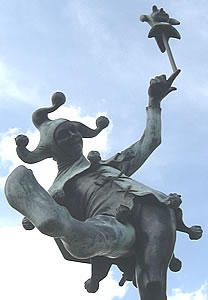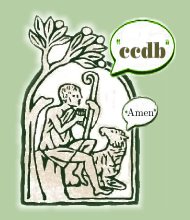A throw-down: Open Book on "Still Evolving"
Get a load of the fires burning over at Amy Welborn's place right here. Sounds like the Reasonable see theocrats everywhere, even in Cardinal's that defend Catholic doctrine. Ah, well. As long as it helps them sleep at night. Behold the fear:
The cardinal's essay was submitted to The Times by a Virginia public relations firm, Creative Response Concepts, which also represents the Discovery Institute.Yeah, that scary Discovery Institute. Ready to warm up a hootinanny at a moment's notice. They got the Willems Jennings Byrant statue in the back. Word is, they plan to start using derivatives on those Bible generation numbers. Maybe they'll get around to proving heliocentricity. I mean, just look at them:
Mr. Ryland, who said he knew the cardinal through the International Theological Institute in Gaming, Austria, where he is chancellor and Mr. Ryland is on the board, said supporters of intelligent design were "very excited" that a church leader had taken a position opposing Darwinian evolution. "It clarified that in some sense the Catholics aren't fine with it," he said.
Bruce Chapman, the institute's president, said the cardinal's essay "helps blunt the claims" that the church "has spoken on Darwinian evolution in a way that's supportive."
But some biologists and others said they read the essay as abandoning longstanding church support for evolutionary biology.
"How did the Discovery Institute talking points wind up in Vienna?" wondered Glenn Branch, deputy director of the National Center for Science Education, which advocates the teaching of evolution. "It really did look quite a bit as if Cardinal Schönborn had been reading their Web pages."
Mission StatementYeah, with a raison d'etra like this, they'll be burning the capital in no time, looking to crown Robertson first King of these United States! Just look at their bible-thumping:
Discovery Institute's mission is to make a positive vision of the future practical. The Institute discovers and promotes ideas in the common sense tradition of representative government, the free market and individual liberty. Our mission is promoted through books, reports, legislative testimony, articles, public conferences and debates, plus media coverage and the Institute's own publications and Internet website ( http://www.discovery.org ).
Current projects explore the fields of technology, science and culture, reform of the law, national defense, the environment and the economy, the future of democratic institutions, transportation, religion and public life, government entitlement spending, foreign affairs and cooperation within the bi-national region of "Cascadia." The efforts of Discovery fellows and staff, headquartered in Seattle, are crucially abetted by the Institute's members, board and sponsors.
We provide below an annotated bibliography of technical publications of various kinds that support, develop or apply the theory of intelligent design.Yeah, you got to hand it to those creationists. They really know how to throw a party!
Featured Articles
Jonathan Wells, “Do Centrioles Generate a Polar Ejection Force? Rivista di Biologia/Biology Forum 98 (2005): 37-62.
Most animal cells contain a pair of centrioles, tiny turbine-like organelles oriented at right angles to each other that replicate at every cell division. Yet the function and behavior of centrioles remain mysterious. Since all centrioles appear to be equally complex, there are no plausible evolutionary intermediates with which to construct phylogenies; and since centrioles contain no DNA, they have attracted relatively little attention from neo Darwinian biologists who think that DNA is the secret of life. From an intelligent design (ID) perspective, centrioles may have no evolutionary intermediates because they are irreducibly complex. And they may need no DNA because they carry another form of biological information that is independent of the genetic mutations relied upon by neo-Darwinists. In this paper, Wells assumes that centrioles are designed to function as the tiny turbines they appear to be, rather than being accidental by-products of Darwinian evolution. He then formulates a testable hypothesis about centriole function and behavior that—if corroborated by experiment could have important implications for our understanding of cell division and cancer. Wells thus makes a case for ID by showing its strong heuristic value in biology. That is, he uses the theory of intelligent design to make new discoveries in biology.
Scott Minnich and Stephen C. Meyer, “Genetic Analysis of Coordinate Flagellar and Type III Regulatory Circuits,” Proceedings of the Second International Conference on Design & Nature, Rhodes Greece, edited by M.W. Collins and C.A. Brebbia (WIT Press, 2004).
This article underwent conference peer review in order to be included in this peer-edited proceedings. Minnich and Meyer do three important things in this paper. First, they refute a popular objection to Michael Behe’s argument for the irreducible complexity of the bacterial flagellum. Second, they suggest that the Type III Secretory System present in some bacteria, rather than being an evolutionary intermediate to the bacterial flagellum, is probably represents a degenerate form of the bacterial flagellum. Finally, they argue explicitly that intelligent design is a better than the Neo-Darwinian mechanism for explaining the origin of the bacterial flagellum.
Peer-Reviewed Books Supportive of Intelligent Design Published by Trade Presses or University Presses
W.A. Dembski, The Design Inference: Eliminating Chance through Small Probabilities (Cambridge: Cambridge University Press, 1998).
This book was published by Cambridge University Press and peer-reviewed as part of a distinguished monograph series, Cambridge Studies in Probability, Induction, and Decision Theory. The editorial board of that series includes members of the National Academy of Sciences as well as one Nobel laureate, John Harsanyi, who shared the prize in 1994 with John Nash, the protagonist in the film A Beautiful Mind. Commenting on the ideas in The Design Inference, well-known physicist and science writer Paul Davies remarks: “Dembski’s attempt to quantify design, or provide mathematical criteria for design, is extremely useful. I’m concerned that the suspicion of a hidden agenda is going to prevent that sort of work from receiving the recognition it deserves.” Quoted in L. Witham, By Design (San Francisco: Encounter Books, 2003), p. 149.
Michael Behe, Darwin’s Black Box: The Biochemical Challenge to Evolution (The Free Press, 1996).
In this book Behe develops a critique of the mechanism of natural selection and a positive case for the theory of intelligent design based upon the presence of “irreducibly complex molecular machines” and circuits inside cells. Though this book was published by The Free Press, a trade press, the publisher subjected the book to standard scientific peer-review by several prominent biochemists and biological scientists.
Charles B. Thaxton, Walter L. Bradley, Roger L. Olsen, The Mystery of Life’s Origin: Reassessing Current Theories (Philosophical Library, 1984, Lewis & Stanley, 4th ed., 1992).
In this book Thaxton, Bradley and Olsen develop a seminal critique of origin of life studies and develop a case for the theory of intelligent design based upon the information content and “low-configurational entropy” of living systems.
John Angus Campbell and Stephen C. Meyer, Darwinism, Design, & Public Education (Michigan State University Press, 2003)
This is a collection of interdisciplinary essays that addresses the scientific and educational controversy concerning the theory of intelligent design. Accordingly, it was peer-reviewed by a philosopher of science, a rhetorician of science, and a professor in the biological sciences from an Ivy League university. The book contains five scientific articles advancing the case for the theory of intelligent design, the contents of which are summarized below.
Needless to say, the screaching of the Reasonable means that the Catholic Church has once again gored one of it's sacred cows. That would be the "scientific evidence" that God doesn't exist, that it's only us, so only we decide. Therefore, I Am the Lord My God, I will Have No Gods Before Me must lead the new commandments. And nothing must get in the way of the One Thing That Matters, with that Sacrament of Abortion to Moloch to ensure that One Thing happens whenever the hell we want it to. The Reasonable got caught poaching some Fools and now they're pouting. Good. I needed a laugh today. The NYT gave me one. Some of the Foolables over at Amy's really helped me fall out of my chair. If you're in need of some laughs, check it out!





















<< Home